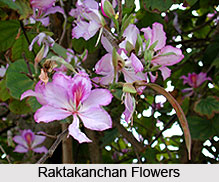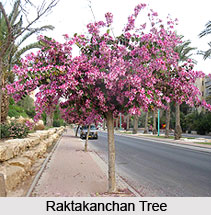 Orchid tree or Raktakanchan is a small, usually evergreen, ornamental tree. The tree looks strikingly beautiful when in bloom which continues for several months. The medicinal properties of Raktachandan or Orchid tree have made it precious among the medicinal plants and it is used hugely by the people of India for treating various diseases. Indian Postal Department had also issued a postal stamp to commemorate this tree.
Orchid tree or Raktakanchan is a small, usually evergreen, ornamental tree. The tree looks strikingly beautiful when in bloom which continues for several months. The medicinal properties of Raktachandan or Orchid tree have made it precious among the medicinal plants and it is used hugely by the people of India for treating various diseases. Indian Postal Department had also issued a postal stamp to commemorate this tree.
Nomenclature of Orchid Tree
The scientific name of Orchid tree is Bauhinia variegata. Raktakanchan is also known as Kachnar in Hindi and Ashmantaka, Chamarika and Chamari in Sanskrit. In Marathi it is called Kanaraj and Kanchan while in Telugu it is referred as Daevakanchanamu and Bodanta. It belongs to the family Caesalpiniaceae which is the Gulmohar family.
 Distribution of Orchid Tree
Distribution of Orchid Tree
Though the native land of this plant is South and Southeast Asia, it is found throughout peninsular India in deciduous forests, usually scattered and nowhere very common, typically along watercourses. This plant is also planted as a garden ornamental throughout India to an altitude of 1300 metre.
Morphology of Orchid Tree
Orchid tree grows to a height of 20 to 40 feet with a width of 10 to 20 feet having a crown of briefly deciduous leaves. Leaves are rigidly subcoriaceous, glabrous and are divided into 2 lobes with almost angular tips. Flowers are different in colour including white, magenta, lavender and purple and grow in terminal and axillaries short-peduncled, lew-flowered panicled racemes. The flowers first appear in late winters when the tree is devoid of leaves and this blooming period lasts till early summer. They have five irregular, slightly overlapping petals. The branches carry clusters of flowers. The fruits of the plant are firm, flat, glabrous, somewhat splashed with red when young.
Medicinal Properties of Orchid Tree
Raktakanchan has numerous medicinal values. The stem bark is credited with astringent properties and is used to treat diarrhoea. In Ayurveda it is used to treat ulcers, swellings, leprosy, cough, menstrual disorders, glandular diseases and prolapse of the rectum. Among the tribal inhabitants of southern Bihar, it is taken in powdered form for this purpose, and is applied to the forehead in the form of a paste to relieve headache. Mixed with curd (yoghurt), it is found to be useful for treating haemorrhoids; made into a paste with ginger, it is taken internally in the treatment of goitre. A decoction of the stem bark is a useful wash for ulcers. The flower buds are reported to have astringent, laxative and anthelmintic properties, and are used to treat haemorrhagic diseases, leucorrhoea and coughs. They are sometimes eaten as a vegetable and also pickled. In Dharmapuri district in Tamil Nadu the leaf paste mixed with the latex of Jatropha curcas (Euphorbiaceae) is given as a remedy for jaundice. The root is considered as carminative, but the root bark is poisonous. The stem bark and flowers are used in Ayurvedic medicine to treat worm infestation, leprosy, wounds, menorrhagia, gout, scrofula, wasting diseases, cough, haemorrhage, urinary disorders, glandular swellings and goitre.











